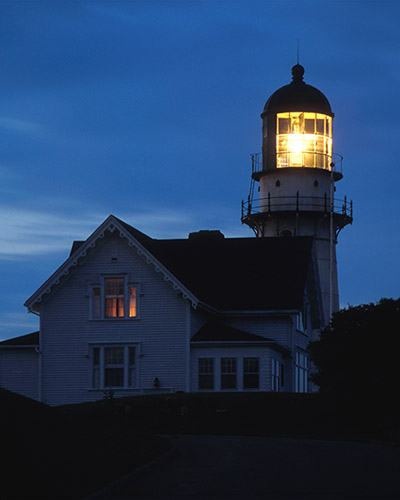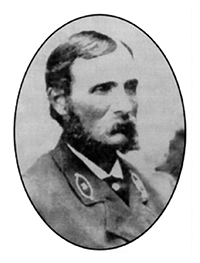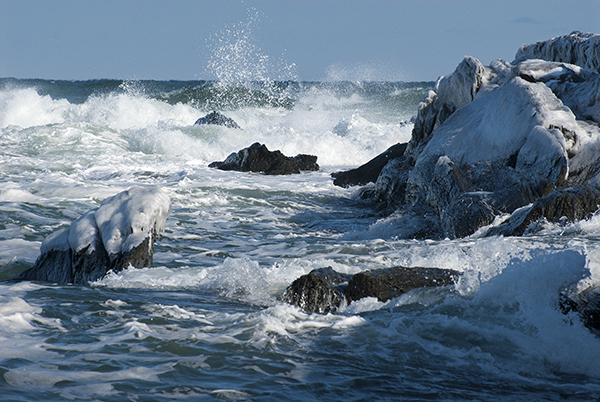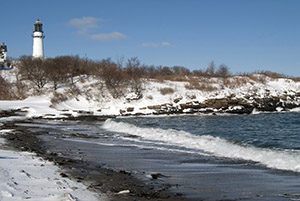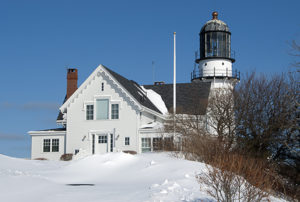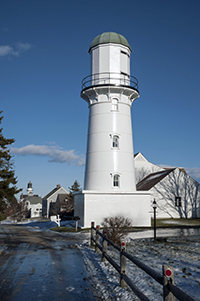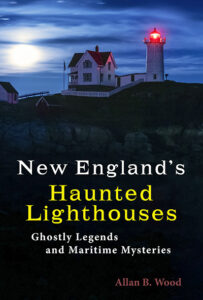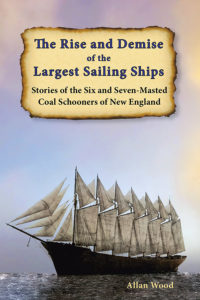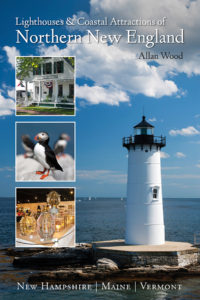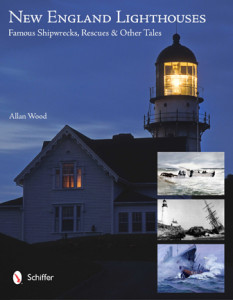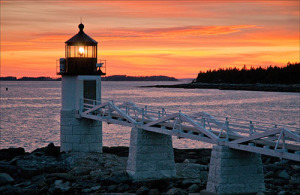Lighthouse Keeper Marcus Hanna Involved in the Most Dangerous Rescue At Cape Elizabeth Light in Maine
Marcus Hanna was transferred to be employed as a keeper to Cape Elizabeth Lighthouse in 1873 from Pemaquid Point Lighthouse. He was to become infamous for one of the most daring rescues in lighthouse history. The rescue is not famous for the number of survivors saved but for the incredible suffering Keeper Hanna endured in his determination to save those in distress, risking his own life in the attempt.
The schooner Australia was carrying a cargo of 150 barrels of mackerel on deck and a load of ice on the 27th of January, 1885. The next day, she was leaving Boothbay, Maine, to deliver her cargo to Boston, Massachusetts. On board were three crewmen: Captain J.W. Lewis, Seaman Irving Pierce, and Seaman William Kellar.
That night, a violent nor’easter storm came over the area with bitterly cold gale-force winds and blinding snow. Keeper Hanna sounded the steam fog whistle all night despite being exhausted from having flu-like symptoms. By daybreak, the keeper trudged back from the tower through large snowdrifts to the keeper’s dwelling to rest. Mrs. Hanna extinguished the lights in both towers while Assistant Keeper Hiram Staples took the morning shift, trying to look for distressed vessels. However, visibility was abysmal due to the ongoing blizzard.
Around midnight that same night during the storm, the Australia had lost her sails from the high winds while attempting to reach Portland Harbor for safety. By 8:00 a.m. that morning on January 28, she crashed on the rocks by Cape Elizabeth Light, near the fog signal. As the seas washed over the wreck, the crewmen had barely enough time to crawl upon the rigging. Captain Lewis lost his grip and was washed overboard, drowning in the icy waters. The two seamen, Pierce and Kellar, were trying to hang on to the rigging in the bitter cold as the temperature had tumbled to minus 10 degrees below zero. As the storm continued, they were drenched in icy water and spray.
At around 8:40 a.m., with the blizzard still unrelenting, Hanna’s wife saw a glimpse of the vessel’s masts on the rocks and shouted to awaken her husband. Keeper Hanna rushed to the signal house with Staples, who hadn’t seen the wreck through the blinding snow. Hanna and Staples hurried to the water’s edge near the schooner, where they observed the two sailors covered in ice clinging to the rigging, looking like ghoulish scarecrows. Hanna yelled that they were coming to help and that the sailors should hang on.
Keeper Hanna’s wife and Staples’ son went to get help from the neighbors, and Hanna and Assistant Keeper Staples decided to try to find materials to rescue the men. The keeper realized he could not launch a boat in the stormy waters, so he crawled through the snow to the fog signal house and grabbed an axe. He and Staples then had to crawl over the snowdrifts to the boathouse 300 yards away and shovel the entrance to get into the building. There, they grabbed a line to rescue the frozen crewmen.
Hanna tied a heavy iron weight he got from the fog signal house to the end of the line and crawled along the icy rocks with the winds still gusting at below-zero temperatures. If he slipped on the rocks in the thunderous surf, it could be a fatal mistake in such freezing waters. When he reached the surf’s edge, he tried several times to throw the line to the vessel but failed. He repeatedly tried unsuccessfully, with the line falling short of its target each time. After many unsuccessful attempts, Keeper Hanna briefly crawled back to the shoreline to warm himself up. He could feel the stinging pain from prolonged exposure as his fingers, hands, and feet started numbing. Staples also suffered from the cold and briefly abandoned the keeper. He returned to the fog signal house to warm up and checked to see if any additional help had arrived.
Suddenly, a huge wave struck the wrecked schooner, smashing her further on the rocks. Hanna knew time was getting short for the men. In exhaustion from his illness and practically frozen as hypothermia engulfed him, he decided to risk his life and waded waist-deep into the icy ocean surf. The waves thrashed around him as he summoned all his strength and again threw a line to the schooner, this time landing it near Pierce. The frozen sailor barely pulled his grasp away from the icy rigging and bent the line around his waist.
With no reply, Hanna returned to the icy rocks and shouted for help. He knew time was slipping away and had to get the men ashore. As soon as he was ready, Pierce signaled to Hanna and jumped into the raging surf. Hanna was determined to save Pierce at any cost and somehow pulled the helpless man through the waves and over the slippery rocks to safety on the shore. Hanna would later write, “Pierce’s jaws were set; he was blind from exposure to the cold, and the expression of his face I shall not soon forget.”
Keeper Hanna realized he couldn’t wait for help to arrive and quickly loosened the line from Pierce’s ice-covered body. He again waded into the surf in sub-zero temperatures and howling winds. After several tries, the line landed within Kellar’s grasp. Also frozen and badly frostbitten, Kellar could barely tie the rope around his waist. Keeper Hanna could feel his strength giving out as he tried to haul Kellar over to safety. Just as Hanna was about to pass out from exhaustion and exposure, Staples and two neighbors arrived and were able to help the keeper haul Kellar to the shore.
The two sailors were then carried to the fog signal building, along with Hanna, where they were given dry clothes, food, and spirits. They were severely frostbitten and could not be moved to the keeper’s dwelling until later that night due to the storm’s intensity and huge snowdrifts. The storm had removed communication within the city, and most roads were closed for a few days. After spending two more days at the keeper’s dwelling, Pierce and Kellar had recovered enough, along with Hanna, to be taken to the marine hospital in Portland by sled. They gradually recovered from what could easily have been a tragedy without the keeper’s determination.
Six months later, in April 1885, Marcus Hanna received a Gold Lifesaving Medal for his selfless heroism in rescuing the two sailors. The incident was to rank as one of the most extraordinary lifesaving feats at an American lighthouse and was one of the highest honors given for heroic service. Hannah also received the distinguished Medal of Honor in 1895 for his bravery in another rescue incident at Port Hudson.
In August 1997, the Coast Guard launched a 175-foot Coast Guard buoy tender vessel named the Marcus Hanna. A replica of Hanna’s lifesaving medal is mounted on board. The ship’s homeport is in South Portland, Maine, near the Cape Elizabeth Lighthouse.
Exploring and Viewing Cape Elizabeth Lighthouse
You can walk from the park to the lighthouses. Cape Elizabeth Lighthouse is a private residence in a quiet neighborhood that you can view easily from the road. It was originally part of two lighthouses as part of range lights, and the other lighthouse, which is capped, can also be viewed inside the neighborhood. Be wary, as these are private residences.
Two Lights State Park, sometimes called Two Lights State Park, offers relaxing picnic tables, hiking trails, and ocean views near the lighthouses.
Cape Elizabeth is also home to Portland Head Lighthouse, the oldest lighthouse in Maine, located a few miles away.
Here are some photos of Cape Elizabeth Lighthouse and its Range Light.
Enjoy!
Allan Wood
Books to Explore
New England’s Haunted Lighthouses:
Ghostly Legends and Maritime Mysteries
Discover the mysteries of the haunted lighthouses of New England! Uncover ghostly tales of lingering keepers, victims of misfortune or local shipwrecks, lost souls, ghost ships, and more. Many of these accounts begin with actual historical events that later lead to unexplained incidents.
Immerse yourself in the tales associated with these iconic beacons!
The Rise and Demise of the Largest Sailing Ships:
Stories of the Six and Seven-Masted Coal Schooners of New England.
In the early 1900s, New England shipbuilders constructed the world’s largest sailing ships amid social and political reforms. These giants were the ten original six-masted coal schooners and one colossal seven-masted vessel, built to carry massive quantities of coal and building supplies and measured longer than a football field! This self-published book, balanced with plenty of color and vintage images, showcases the historical accounts that followed these mighty ships.
Available also from bookstores in paperback, hardcover, and as an eBook for all devices.

Book – Lighthouses and Coastal Attractions in Southern New England: Connecticut, Rhode Island, Massachusetts
Lighthouses and Coastal Attractions of Southern New England:
Connecticut, Rhode Island, and Massachusetts.
This 300-page book provides memorable human interest stories from each of the 92 lighthouses. You can explore plenty of indoor and outdoor coastal attractions, including whale-watching excursions, lighthouse tours, windjammer sailing tours, parks, museums, and even lighthouses where you can stay overnight. You’ll also find plenty of stories of hauntings around lighthouses.
Lighthouses and Coastal Attractions of Northern New England:
New Hampshire, Maine, and Vermont.
This 300-page book provides memorable human interest stories from each of the 76 lighthouses, such as the story of Marcus Hanna’s rescue at Cape Elizabeth Light in Maine. It also describes and provides contact info for plenty of indoor and outdoor coastal attractions and tours. These include whale watching, lighthouse tours, unique parks, museums, and lighthouses where you can stay overnight. There are also stories of haunted lighthouses in these regions.
New England Lighthouses:
Famous Shipwrecks, Rescues & Other Tales
This book contains over 40 stories, including Marcus Hanna’s rescue at Cape Elizabeth Lighthouse in southern Maine. It is also image-rich, with vintage images provided by the Coast Guard and various organizations and paintings by six famous Coast Guard artists.
You can purchase this book and the lighthouse tourism books from the publisher Schiffer Books or in many fine bookstores such as Barnes and Noble.
Copyright © Allan Wood Photography; do not reproduce without permission. All rights reserved.
Join, Learn, and Support The American Lighthouse Foundation
